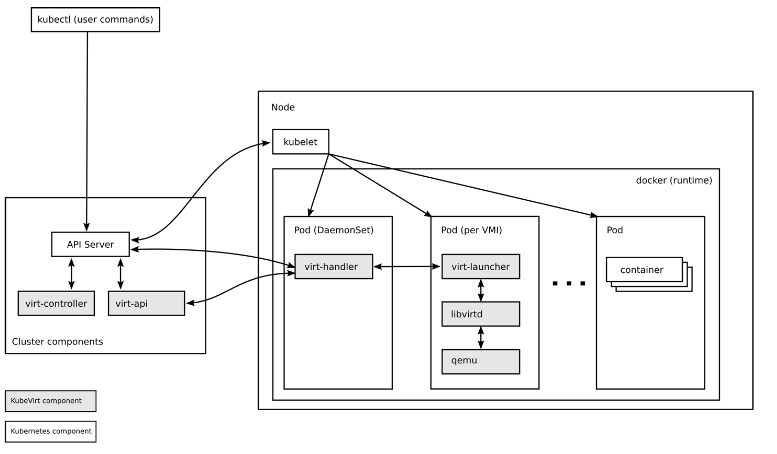KubeVirt Architecture¶
The following diagram describes the KubeVirt architecture:

virt-api-server
HTTP API server serves as the entry point for all virtualization related flows.
The API server updates the virtualization related custom resource definition (see below).
As the main entry point to KubeVirt it is responsible for defaulting and validation of the provided VMI CRDs.
VMI (CRD)
VMI definitions are kept as custom resources inside the Kubernetes API server.
The VMI definition defines all properties of the VM itself, for example:
Machine type
CPU type
Amount of RAM and vCPUs
Number and type of NICs
virt-controller
The virt-controller has all the cluster wide virtualization functionality
and it is responsible for monitoring the VMI (CRs) and managing the
associated pods. Currently, the controller ensure the creation and management
of the life-cycle of the pods associated with the VMI objects.
A VMI object will always be associated with a pod during its life-time. However, migration of a VMI the pod instance might change over time.
virt-launcher
For every VMI object one pod is created. This pod’s primary container runs
the virt-launcher KubeVirt component.
Kubernetes or kubelet is not running the VMIs. Instead a daemon on every host in the cluster launches a VMI process for every pod which is associated with a VMI object whenever it is scheduled on a host.
The main purpose of the virt-launcher pod is to provide cgroups and
namespaces, used to host the VMI process.
virt-handler signals virt-launcher to start a VMI by passing the
VMI’s CRD object to virt-launcher. virt-launcher uses a local
libvirtd instance within its container to start the VMI. The
virt-launcher monitors the VMI process and terminates once the VMI has
exited.
If the Kubernetes runtime attempts to shutdown the virt-launcher pod before
VMI has exited, virt-launcher forwards signals from Kubernetes to the
VMI process and attempts to hold off the termination of the pod until the
VMI has shutdown successfully.
virt-handler
Every host needs a single instance of virt-handler. It can be delivered as
a DaemonSet.
Like the virt-controller, the virt-handler is also reactive and watches
for changes of the VMI object, once detected it will perform all necessary
operations to change a VMI to meet the required state.
This behavior is similar to the choreography between the Kubernetes VMI server and the kubelet.
The functions of the virt-handler are:
Keeps a cluster-level VMI specification in sync with a corresponding
libvirtdomain.Reports domain state and spec changes to the cluster.
Invokes node-centric plugins which can fulfill networking and storage requirements defined in VMI specs.
Libvirtd
An instance of libvirtd is present in every VMI pod. virt-launcher
uses libvirtd to manage the life-cycle of the VMI process.
Additional components from StarlingX Kubernetes are:
Storage
Networking
RBAC
Simplified Diagram

Containerized Data Importer¶
The CDI project provides facilities for enabling PVCs to be used as disks for KubeVirt VMs by way of DataVolumes. The three main CDI use cases are:
Import a disk image from a web server or container registry to a DataVolume.
Clone an existing PVC to a DataVolume.
Upload a local disk image to a DataVolume.
